10 Places To Visit In Hampi
By: Priyanka Maheshwari Fri, 06 Oct 2023 6:12:00
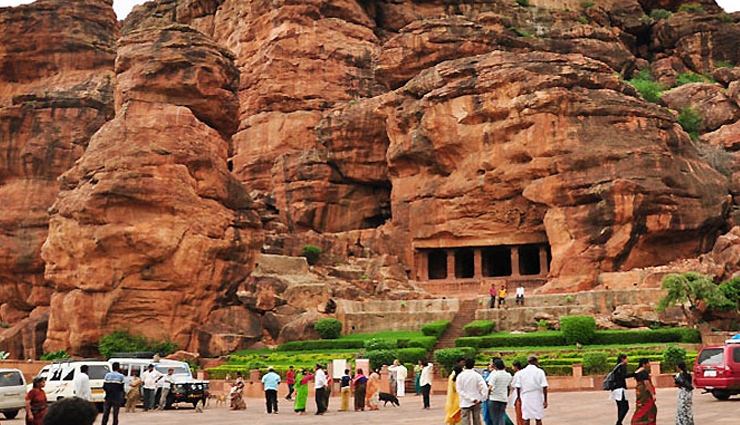
Hampi, nestled in the heart of Karnataka, India, is a land steeped in history, mystery, and architectural marvels. This UNESCO World Heritage site is a treasure trove of ancient ruins, temples, and a surreal landscape that transports visitors to a bygone era. Renowned as the capital of the Vijayanagara Empire, Hampi boasts a rich historical and cultural heritage that beckons travelers from across the globe. In this enchanting destination, time seems to stand still as you explore its iconic landmarks and delve into the intriguing tales of its past. Join us on a journey through the top places to visit in Hampi, where history comes alive, and every stone whispers a story.
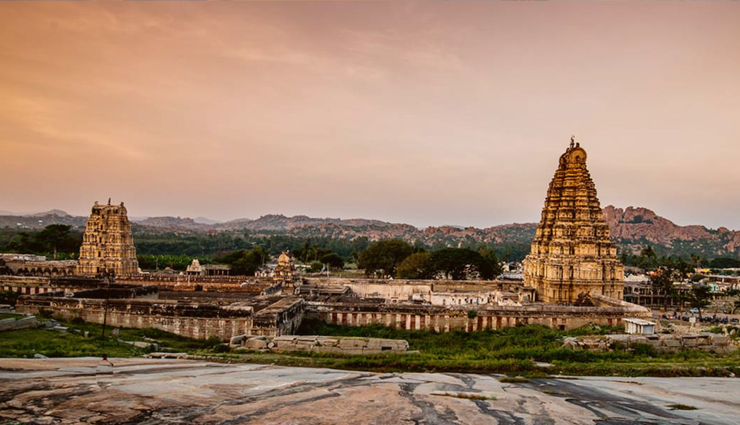
# Virupaksha Temple
Nestled in the heart of the ancient ruins of Hampi, the Virupaksha Temple stands as a testament to the enduring spiritual and architectural legacy of India. This magnificent temple is not only a prominent pilgrimage site but also a treasure trove of historical and artistic wonders that draw visitors from all corners of the world.
A Timeless Sanctuary
The Virupaksha Temple is one of the oldest functioning temples in India, with a history that stretches back over a thousand years. It is dedicated to Lord Virupaksha, an incarnation of Lord Shiva, making it a significant pilgrimage destination for devotees of the deity.
Architectural Grandeur
One of the most striking features of the Virupaksha Temple is its awe-inspiring architecture. The temple complex is a harmonious blend of various architectural styles, with elements that have evolved over centuries. From intricately carved pillars and towering gopurams (entrance towers) to ornate ceilings and sanctums, every inch of this temple is a work of art.
The Fascinating Hampi Bazaar
Adjacent to the temple lies the bustling and vibrant area known as the Hampi Bazaar. This thriving market has been in operation for centuries, catering to the needs of pilgrims and travelers alike. As you stroll through its narrow lanes, you'll encounter a myriad of stalls selling traditional handicrafts, souvenirs, and local cuisine. It's a sensory delight, with the fragrance of incense wafting through the air and the lively chatter of traders filling the atmosphere.
Sacred Rituals and Festivals
The Virupaksha Temple is not just a historical relic; it's a living, breathing spiritual center. Daily rituals and ceremonies are performed with great devotion, allowing visitors to witness the timeless traditions of Hindu worship. The temple also hosts various festivals throughout the year, with the annual Virupaksha Car Festival being a highlight. During this grand event, the deity is placed in a chariot adorned with flowers and is paraded through the streets, accompanied by enthusiastic devotees.
A Gateway to Explore
Beyond its religious and architectural significance, the Virupaksha Temple serves as a gateway to the other incredible wonders of Hampi. The temple's proximity to the Tungabhadra River and other historic sites makes it an ideal starting point for exploring the region's rich history and natural beauty. Whether you're an architecture enthusiast, a history buff, or a spiritual seeker, this temple has something profound to offer.
Visiting the Virupaksha Temple in Hampi is more than a journey through time; it's an opportunity to connect with the spiritual essence of India and immerse yourself in the grandeur of its past. As you stand in the shadow of its magnificent towers, you can't help but feel a profound sense of awe and reverence for the enduring legacy of this sacred place.
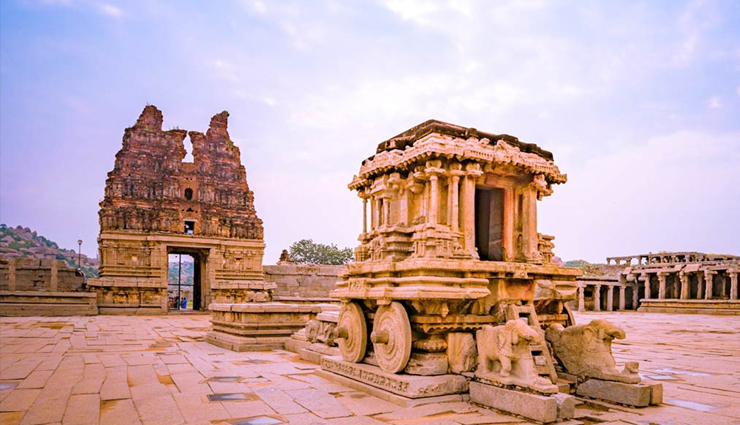
# Vithala Temple
In the heart of the captivating ruins of Hampi, the Vithala Temple stands as a testament to the exquisite craftsmanship and architectural brilliance of ancient India. This temple, dedicated to Lord Vithala, is not merely a religious site but a living testament to the artistic grandeur and engineering marvels of the Vijayanagara Empire.
A Symphony of Stone
Vithala Temple is renowned for its exceptional architecture, characterized by its intricately carved pillars, ornate halls, and impressive stone chariot. The temple complex is a harmonious blend of intricate carvings, splendid sculptures, and awe-inspiring structures. The highlight of the temple is the iconic stone chariot, a magnificent monolithic structure that represents the artistic zenith of Vijayanagara architecture.
The Musical Pillars
One of the most fascinating features of Vithala Temple is its musical pillars. These pillars, when struck, produce musical notes that resemble the sounds of various musical instruments. Each pillar is intricately carved and emits distinct musical tones when tapped, leaving visitors in awe of the ancient architects' mastery of acoustics.
The Stone Chariot – A Marvel of Artistry
The Stone Chariot, located within the temple complex, is perhaps the most iconic structure in Hampi. Carved out of a single rock, this intricately designed chariot resembles a mobile temple and is dedicated to Garuda, the divine eagle and vehicle of Lord Vishnu. The chariot's wheels, with their detailed carvings and precise engineering, add to the temple's allure, making it a symbol of architectural brilliance.
Rich Mythological Depictions
The walls of Vithala Temple are adorned with exquisite bas-reliefs and sculptures depicting various mythological stories and scenes from ancient epics like the Ramayana and Mahabharata. These artistic renditions not only showcase the artistic skills of the craftsmen but also provide a visual narrative of the rich Indian mythology.
The Hampi Utsav
Vithala Temple comes to life during the annual Hampi Utsav, a vibrant festival that celebrates the region's cultural heritage. The temple serves as the focal point of the festivities, with classical dance performances, music concerts, and traditional processions adding to the temple's lively atmosphere.
A Spiritual and Architectural Odyssey
Visiting Vithala Temple is not just a historical exploration but a spiritual and architectural odyssey. It offers visitors a chance to marvel at the ingenuity of ancient artisans and immerse themselves in the spiritual ambiance of this sacred site. As you walk through its hallowed halls and admire its intricate carvings, you can't help but be transported back in time, experiencing the grandeur of a bygone era.
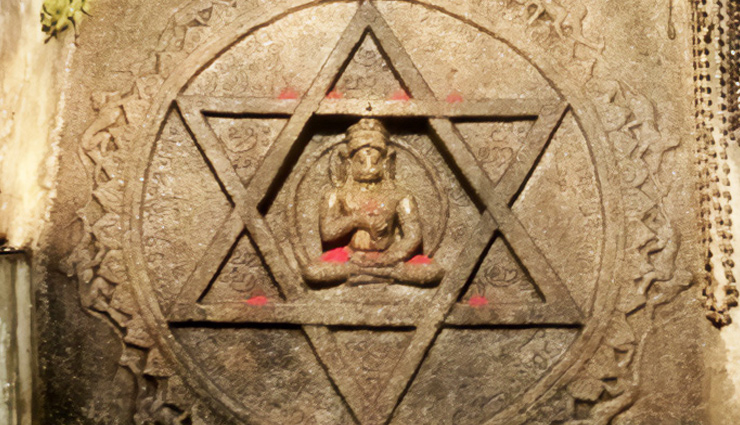
# Yantrodharaka Hanuman Temple
Yantrodharaka Hanuman Temple is one of the significant temples located in Hampi, Karnataka, India. It holds immense religious and historical importance in the region. Here is some information about the Yantrodharaka Hanuman Temple:
Location:
The Yantrodharaka Hanuman Temple is situated in the ancient ruins of Hampi, a UNESCO World Heritage Site, in the state of Karnataka, India. It is located near the Virupaksha Temple, one of the iconic landmarks of Hampi.
Religious Significance:
The temple is dedicated to Lord Hanuman, a revered deity in Hinduism known for his devotion, strength, and loyalty. The Yantrodharaka Hanuman Temple is considered sacred by devotees who visit to seek the blessings and protection of Lord Hanuman.
Architecture:
The temple features traditional Dravidian architecture, typical of many South Indian temples. It is adorned with intricate carvings and sculptures, showcasing the rich heritage of Hampi. The surroundings offer a serene atmosphere, making it a peaceful place for prayer and meditation.
Yantrodharaka Hanuman:
The term "Yantrodharaka" refers to the bearer of the mystical Yantra, a sacred geometric diagram used in meditation and worship. According to the temple's legend, Lord Hanuman holds a powerful Yantra, and devotees believe that worshiping him here can bring spiritual enlightenment and protection from negative energies.
Visiting Hampi:
Apart from the Yantrodharaka Hanuman Temple, Hampi boasts numerous other temples, ancient ruins, and architectural marvels that attract tourists and history enthusiasts from around the world. Exploring the Hampi ruins offers a glimpse into the glorious Vijayanagara Empire, showcasing the artistic and cultural achievements of ancient India.

# Hampi Bazaar
Hampi Bazaar, located in the heart of the ancient town of Hampi in Karnataka, India, is a bustling and vibrant market area that offers a unique blend of history, culture, and commerce. Here is some information about Hampi Bazaar:
Historical Significance:
Hampi Bazaar is situated close to the Virupaksha Temple, one of the oldest and most important temples in Hampi. The bazaar area has historical significance, as it was once a thriving marketplace during the prosperous Vijayanagara Empire (14th to 16th centuries). Traders from different parts of the world used to gather here, making it a major hub for trade and commerce.
Architectural Marvels:
The market is flanked by ancient structures, many of which are remnants of the Vijayanagara Empire. Visitors can admire the architecture of old pavilions, arches, and colonnades that have stood the test of time. These structures provide a glimpse into the grandeur of the past and the architectural brilliance of the Vijayanagara civilization.
Shopping and Souvenirs:
Today, Hampi Bazaar is a lively market where visitors can shop for a variety of items, including traditional clothing, jewelry, handicrafts, and souvenirs. The market offers an array of colorful and culturally rich products that reflect the heritage of the region. Tourists often find unique artifacts and memorabilia to take back as reminders of their visit to Hampi.
Street Food and Local Cuisine:
The bazaar area is dotted with small eateries and food stalls that serve local delicacies and street food. Visitors can indulge in authentic South Indian cuisine, snacks, and beverages while exploring the market. Trying local dishes adds to the overall experience of Hampi Bazaar.
Cultural Hub:
Apart from shopping and dining, Hampi Bazaar serves as a cultural hub. Visitors may encounter street performers, artists, and musicians showcasing traditional music and dance forms. The lively atmosphere and cultural events make Hampi Bazaar a delightful place to immerse oneself in the local culture.
Tourist Attractions Nearby:
Hampi Bazaar is strategically located near several important landmarks, including the Virupaksha Temple, Hemakuta Hill, and the Hampi Monuments. Tourists can explore these attractions and then unwind in the vibrant ambiance of the bazaar.
Visiting Hampi Bazaar:
Visitors to Hampi Bazaar can expect a unique and immersive experience, where the historical charm of the market converges with modern commerce. The market is an excellent place to shop for souvenirs, savor local cuisine, and witness the cultural richness of Hampi.

# Hippie Island
Hippie Island, officially known as Virupapur Gadde, is a picturesque and laid-back destination located in Hampi, Karnataka, India. It is a small, serene island on the Tungabhadra River, accessible by coracle boat rides from the Hampi side. Here is more information about Hippie Island:
Tranquil Retreat:
Hippie Island is renowned for its peaceful atmosphere, making it a favorite spot for travelers seeking relaxation and a break from the hustle and bustle of city life. Surrounded by the gentle flow of the Tungabhadra River and lush greenery, the island offers a serene environment for visitors.
Scenic Beauty:
The island is blessed with natural beauty, including stunning river views, rocky landscapes, and lush paddy fields. Travelers often visit to enjoy the picturesque sunsets over the river, creating a magical ambiance on the island.
Hippie Vibe:
The island earned its nickname due to the bohemian and free-spirited travelers who have been visiting and residing here for decades. It has a relaxed and laid-back vibe, with rustic guesthouses, cafes, and open-air restaurants that cater to the backpacker community. Travelers can unwind in hammocks, enjoy live music, and engage in conversations with fellow travelers.
Accommodation and Cafes:
Hippie Island offers a range of accommodation options, including budget guesthouses, huts, and treehouses. Many of these accommodations are eco-friendly and blend harmoniously with the natural surroundings. The island is also home to several cozy cafes and eateries serving a variety of cuisines, including Indian, Israeli, and continental dishes.
Yoga and Wellness:
Given its tranquil setting, Hippie Island has become a hub for yoga enthusiasts and wellness seekers. Many guesthouses and cafes offer yoga classes, meditation sessions, and holistic therapies, providing visitors with the opportunity to rejuvenate their mind, body, and soul.
Adventure Activities:
Apart from relaxation, the island offers adventure activities such as rock climbing, bouldering, and nature walks. The rocky terrain and scenic surroundings make it an ideal destination for outdoor enthusiasts.
Exploring Surrounding Areas:
Hippie Island serves as a base for exploring the Hampi ruins and nearby attractions. Travelers can easily access the UNESCO World Heritage Site of Hampi, which is just a short boat ride away. The island's strategic location allows visitors to enjoy the historical and cultural wonders of Hampi during the day and retreat to the peaceful island in the evenings.
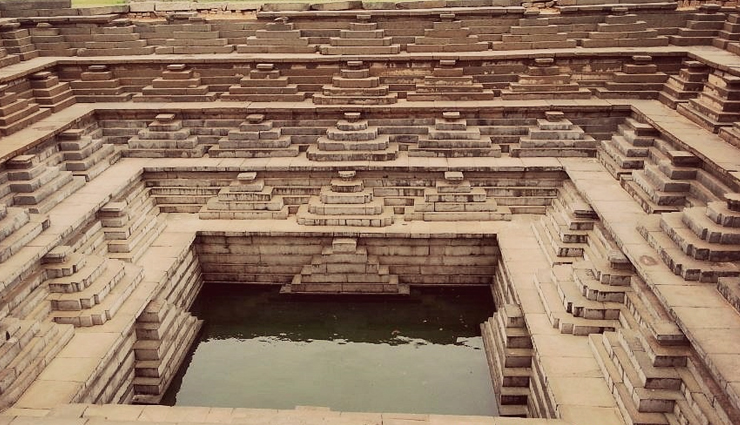
# Queen's Bath
Queen's Bath stands as a testament to the opulence and architectural brilliance of the Vijayanagara Empire. This ancient royal retreat, located in the heart of Hampi's Royal Enclosure, offers a glimpse into the grandeur of the bygone era. Visitors to Hampi are captivated by the intricate design, historical significance, and serene ambiance of the Queen's Bath.
Historical Significance:
Built during the 15th century, the Queen's Bath served as a private bathing chamber for the royal women of the Vijayanagara Empire. The structure's architectural finesse showcases the empire's prosperous period and their dedication to art and culture.
Architecture:
The Queen's Bath is an exquisite blend of Indo-Islamic and Vijayanagara architectural styles. The outer walls of the structure are plain and unadorned, giving no indication of the grandeur within. Upon entering, visitors are greeted by a rectangular pool in the center, surrounded by a veranda with ornate arched windows. The pool, once filled with perfumed water, reflects the architectural elegance of the time.
Intricate Detailing:
What makes the Queen's Bath truly remarkable is its intricate detailing. The walls and ceilings are adorned with delicate stucco work and carvings, showcasing floral motifs, gods, and mythical creatures. The interplay of light and shadow accentuates the beauty of these intricate designs, mesmerizing visitors with the craftsmanship of the artisans.
Purpose and Functionality:
The Queen's Bath served not only as a bathing area but also as a place for the royal women to relax and indulge in recreational activities. The ingenious architecture allowed the chambers to be filled with water from an underground drainage system, ensuring a constant flow of fresh water for the bath.
Visiting Experience:
Today, the Queen's Bath stands in partial ruins, yet its charm remains intact. Visitors exploring Hampi can step back in time as they wander through the remnants of this once-luxurious bathing complex. The serene atmosphere and historical aura make it a must-visit site for history enthusiasts, photographers, and travelers seeking a glimpse into India's rich heritage.
Preservation Efforts:
Efforts have been made to preserve the Queen's Bath and other Hampi monuments, ensuring that future generations can continue to marvel at the architectural marvels of the past. Preservation initiatives aim to protect the site from further deterioration and provide educational insights into its historical and cultural significance.

# Matanga Hill
Matanga Hill, situated amidst the iconic ruins of Hampi in Karnataka, stands as a majestic sentinel overlooking the magnificent Vijayanagara Empire. Rising 300 feet above the ground, this hill is not just a geographical elevation but a vantage point that provides visitors with a breathtaking panoramic view of Hampi's historic landscape. Its serene ambiance, coupled with the allure of ancient relics, makes it a must-visit destination for travelers seeking a profound connection with Hampi's rich heritage.
Historical Significance:
Matanga Hill finds mention in various Hindu mythological texts and local folklore, adding a layer of mystique to its historical significance. It is believed to be the spot where Lord Matanga, a sage from Hindu mythology, meditated and imparted wisdom to his disciples. Over the centuries, this hill witnessed the rise and fall of the Vijayanagara Empire, making it an essential part of Hampi's cultural tapestry.
Journey to the Summit:
The ascent to Matanga Hill involves a moderate trek, adding an adventurous element to the experience. Visitors can embark on a trekking expedition, navigating through winding pathways and rugged terrain. The journey to the summit is not just a physical adventure but also a spiritual and cultural odyssey, as travelers encounter scattered ruins, ancient temples, and inscriptions along the way.
Panoramic Views:
Upon reaching the pinnacle, visitors are rewarded with a captivating 360-degree view of Hampi's architectural marvels. The ruins of Hampi, including the Virupaksha Temple, Achyutaraya Temple, Hemakuta Hill, and the Tungabhadra River, sprawl below like a tableau of ancient splendor. The sunrise and sunset vistas from Matanga Hill are especially enchanting, painting the sky with hues of gold and crimson.
Spiritual Aura:
Matanga Hill exudes a tranquil aura, making it an ideal spot for meditation and introspection. The quietude of the surroundings, coupled with the distant echoes of Hampi's glorious past, creates an ambiance conducive to spiritual contemplation. Travelers often find solace in the embrace of this hill, connecting with the spiritual energy that permeates the site.
Photographer's Paradise:
For photographers and enthusiasts, Matanga Hill offers unparalleled opportunities to capture the essence of Hampi. The play of light and shadow on the ancient ruins, the silhouettes of temples against the twilight sky, and the verdant landscapes below provide endless inspiration for artistic endeavors.
Preservation Efforts:
Matanga Hill, like many other sites in Hampi, benefits from preservation efforts aimed at maintaining its historical integrity. Conservation initiatives ensure that the hill retains its natural beauty and cultural significance, allowing future generations to experience its timeless allure.
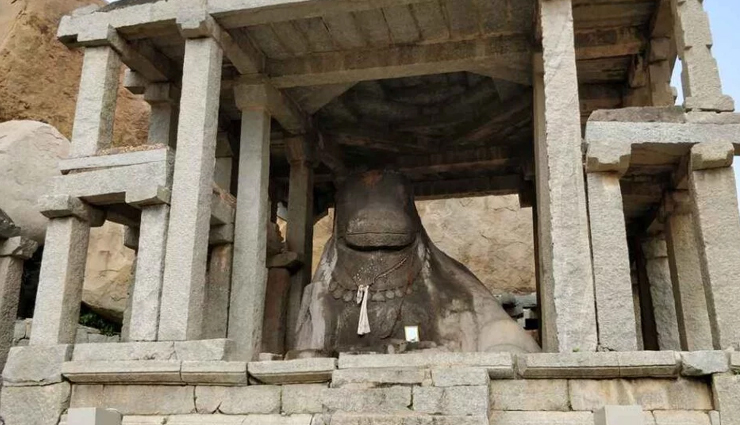
# Monolith Bull
In the heart of the ancient ruins of Hampi, Karnataka, stands a magnificent testament to the artistic brilliance and cultural significance of the Vijayanagara Empire - the Monolithic Bull. Carved out of a single granite rock, this colossal sculpture not only portrays the engineering marvels of its time but also represents the sacred and revered animals in Hindu mythology. The Monolithic Bull, also known as the Nandi or the Basava, has become an iconic symbol of Hampi's grandeur and heritage.
Historical Significance:
The Monolithic Bull is intricately linked to Hindu mythology, where Nandi, the sacred bull, is considered the divine vehicle and devoted follower of Lord Shiva. In Hampi, this massive sculpture is believed to guard the sacred Virupaksha Temple, dedicated to Lord Shiva. Its presence adds an aura of sanctity and spirituality to the entire temple complex.
Architectural Marvel:
Carved during the Vijayanagara period, the Monolithic Bull stands as a remarkable example of ancient Indian sculpture and architecture. Hewn out of a single granite block, the sculpture's intricate details, such as the ornate jewelry adorning the Nandi, showcase the artisans' exceptional craftsmanship. The colossal size of the sculpture, with dimensions reaching colossal heights, adds to its awe-inspiring presence.
Religious Significance:
The Nandi is not just a decorative element in Hindu temples; it holds immense religious importance. Devotees believe that Nandi acts as an intermediary between the worshiper and Lord Shiva, conveying prayers and offerings to the deity. Pilgrims visiting the Virupaksha Temple often pay their respects to the Monolithic Bull before entering the inner sanctum, considering it an auspicious ritual.
Tourist Attraction:
For tourists and history enthusiasts, the Monolithic Bull is a captivating sight. Visitors marvel at the sheer size and intricate detailing of the sculpture, capturing photographs to immortalize their Hampi experience. The site surrounding the Monolithic Bull also provides a serene atmosphere, allowing travelers to absorb the spiritual ambiance and delve into the historical significance of the sculpture.
Preservation Efforts:
Efforts have been made to preserve the Monolithic Bull and other heritage structures in Hampi. Conservationists and archaeologists work diligently to protect these ancient artifacts from natural erosion and human-related damage, ensuring that future generations can continue to admire and appreciate the rich cultural heritage of Hampi.
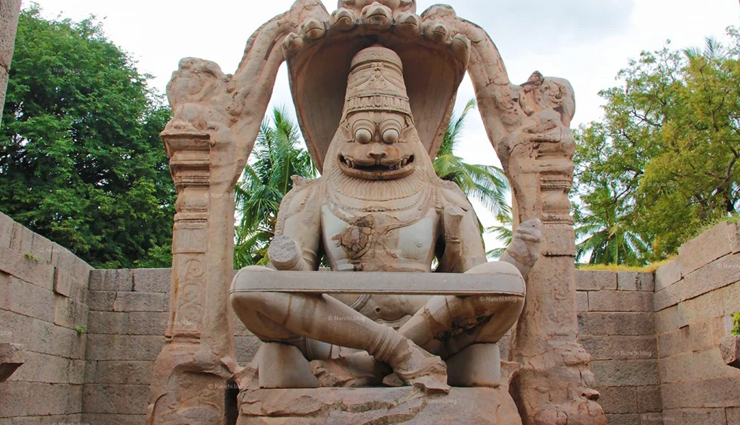
# Lakshmi Narasimha Temple
Lakshmi Narasimha Temple stands as a testament to the architectural brilliance and spiritual devotion of the Vijayanagara Empire. Dedicated to Lord Narasimha, an incarnation of Lord Vishnu, this temple is a masterpiece of ancient Indian craftsmanship and a revered pilgrimage site. Surrounded by the enigmatic aura of Hampi's historical remnants, the Lakshmi Narasimha Temple beckons travelers and devotees alike to explore its divine grandeur.
Historical Significance:
Built during the 15th century by King Krishnadevaraya, the Lakshmi Narasimha Temple symbolizes the religious harmony and cultural richness of the Vijayanagara Empire. The temple is renowned for its unique idol of Lord Narasimha, depicted with a distinct blend of human and lion features, signifying the deity's fierce yet protective nature. Devotees believe that Lord Narasimha safeguards them from all adversities, making the temple a revered sanctuary for spiritual seekers.
Architectural Marvel:
The Lakshmi Narasimha Temple showcases exquisite Dravidian architecture, characterized by intricately carved pillars, ornate sculptures, and detailed reliefs depicting mythological narratives. The colossal idol of Lord Narasimha, seated in a cross-legged yogic posture, dominates the temple's sanctum sanctorum. Despite the damage incurred over centuries, the temple's remaining structure evokes a sense of awe and admiration, leaving visitors mesmerized by its ancient splendor.
Religious Significance:
Devotees visit the Lakshmi Narasimha Temple to seek blessings for protection, courage, and spiritual enlightenment. The temple holds significant religious ceremonies during festivals and auspicious occasions, drawing pilgrims from various parts of the country. The tranquil ambiance and spiritual energy within the temple complex create a conducive environment for meditation and introspection.
Tourist Attraction:
For tourists, the Lakshmi Narasimha Temple offers a glimpse into the rich heritage of Hampi. Exploring the temple's intricate carvings and observing the idol's divine presence captivate the senses and provide a deeper understanding of ancient Indian artistry and spirituality. The temple's surroundings, often adorned with blooming flowers and echoing with Vedic chants, enhance the overall experience, making it a must-visit site in Hampi.
Preservation Efforts:
Efforts are ongoing to preserve the Lakshmi Narasimha Temple and other heritage structures in Hampi. Conservationists and archaeologists work tirelessly to safeguard the temple from natural wear and tear, ensuring that its architectural marvel continues to inspire generations to come.

# Daroji Bear Sanctuary
Daroji Bear Sanctuary stands as a testament to nature's wonders and conservation efforts. Spread across acres of rocky hills and lush landscapes, this sanctuary is a haven for the Indian Sloth Bear, a species native to the Indian subcontinent. Established with the aim of protecting these incredible creatures and their natural habitat, the sanctuary has become a significant wildlife destination and an educational hub for nature enthusiasts.
Historical Significance:
While Hampi is renowned for its ancient ruins and historical significance, the Daroji Bear Sanctuary adds a unique ecological dimension to the region. The sanctuary is situated close to the UNESCO World Heritage Site of Hampi, creating a harmonious blend of historical allure and wildlife preservation. The coexistence of historical remnants and natural habitats showcases the delicate balance between human heritage and biodiversity.
Wildlife Diversity:
Apart from the iconic Indian Sloth Bears, the Daroji Bear Sanctuary is home to a diverse array of flora and fauna. Visitors can spot various species of birds, reptiles, and small mammals as they explore the sanctuary's trails. The sanctuary's rich biodiversity provides a glimpse into the intricate web of life and the importance of preserving natural habitats for the well-being of both animals and humans.
Conservation Efforts:
Conservationists and wildlife enthusiasts have played a crucial role in the sanctuary's success. Efforts to preserve the Indian Sloth Bear population and their habitat include community education, anti-poaching initiatives, and habitat restoration programs. These endeavors have not only protected the bears but have also created awareness about the importance of wildlife conservation among the local communities and visitors.
Visitors' Experience:
For nature lovers and wildlife enthusiasts, the Daroji Bear Sanctuary offers a unique and thrilling experience. Guided safaris and trekking expeditions provide opportunities to observe these fascinating bears in their natural habitat. The sanctuary's picturesque landscapes, coupled with the chance to witness these majestic animals, create unforgettable memories for visitors, fostering a sense of appreciation for the natural world.
Educational Significance:
The Daroji Bear Sanctuary serves as an outdoor classroom, educating visitors about the delicate ecosystems and the significance of biodiversity. Educational programs, nature walks, and interactive sessions enhance visitors' understanding of wildlife conservation, promoting a sense of responsibility towards protecting our natural heritage.
Preserving the Wilderness:
As visitors explore the Daroji Bear Sanctuary, they become a part of the conservation journey, contributing to the sanctuary's mission of preserving the wilderness. By fostering an environment of respect, understanding, and coexistence, the sanctuary ensures that future generations can continue to marvel at the beauty of these incredible creatures and the ecosystems they inhabit.





